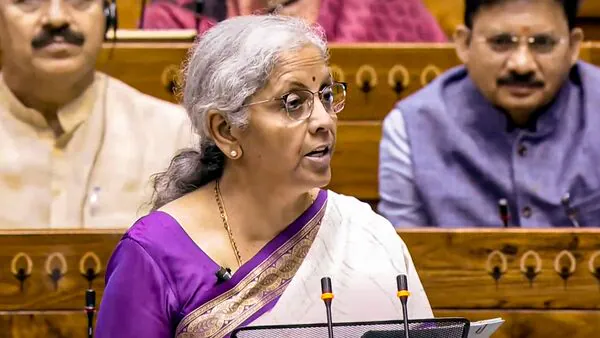India's budget for 2024-25 estimates the Union government sspending to be around k48 tril-lion. From traditional budgeting for 'inputs.' steps have been taken in the last few years to disclose and drawattention to 'outcomes' that tangibly impact the lives of citizens. We now need to take it a step further, ensuring that budget spending drives 'outcome' delivery, by directly linking expenditure with the achievement of results. The principle of"pay for results' means that the government pays implementers only if they meet or exceed pre-set 'outcome' targets, rather than just making provisions for infrastructure or services that go into achieving those outcomes.
Traditionally, budget allocation is done on the basis of expenditures on 'inputs' like salaries, office suppliesand equipment. Linking budgetary spending with the desired impact has remained far from ideal. In recent years, budget planning has begun to make outcomes its focus. The Outcomes Budget document of 2024-25 lays out a clear framework that includes outcomes, indicators and targets to be achieved. Raising the salience of this thought process helps policymakers optimize spending on activities that are likely to maximize impact. For instance, school education outcomes include enhancing access, improving learning. retention and transition rates, and reducing drop-outs, apart from promoting vocational education. This helps policymakers allocate more funds to inputs that drive these specific outcomes.
As next steps, two further evolutions are critical.First is in the way outcomes are defined. Second, we must prioritize approaches that would ensure attaining targets. In determining budget priorities, the first crucial step is to define outcomes.
Should we prioritize immediate and intermediary outcomes driven by short-term needs, or should our focus be on real outcomes that fundamentally transform lives? The answer lies in balancing current exigencies with long-term goals. Take education, where universal access has been a milestone achieved, yet the ultimate out come of elevating learning levels and securing students' socio-economic well-being demands deeper attention. Similarly, in health-care, outcomes like improving patients quality of life or rewarding practices that reduce their hospital visits must guide resource allocation. Road infrastructure, too, should not merely aim at con-struction, but also measure success by its economic impact on local communities. Aligning outlays with transformative outcomes will ensure sustained progress. While intermediary outcomes act as stepping stones, prioritizing enduring impacts as our north starensures that every budgetary decision propels us towards a more equitable and prosperous future, where tangible improvements in people's lives are the true measure of success.
Secondly, while the current budget allocation is meant to deliver certain results, the spending is still not linked with meeting outcome targets or not. It's still linked to input activity. In a scenario where budget spending and result-achievement are delinked, the delivery mechanisms of the implementer may not evolve toa level that's needed to deliver results, and innovations remain subdued. In some cases, despite spending the entire budgetary allocation on an activity, targets go unmet. The journey towards defining and measuring advanced forms of end-outcomes will need discovery. In this direction, a few initial pilots of'pay for results' were announced by the finance minister in the 2023-24 Union budget.
The Niti Aayog, in association with Dell Foundation and GDi Partners, initiated a pilot project in the education domain, where a part of the payment to information and communication technology (ICT) providers that set up computer labs in government schools is linked to "Improvement in learning levels of the students" (the key 'outcome').
Implemented in select 'aspirational districts' in Uttar Pradesh, early results show that it drives ICT providers and schools to prioritize activities that directly improve students' learning levels. ICT providers are found to be going the extra mile to keep labs fully operational, ensure better lab usage, provide quality learning content, support teachers and help implement learning-focused practices An independent impact assessment showed that within a year of implementation, the learningof students who used these labs improved by a factor of three over those who did not.
Similarly, National Skills Development Corporation (NSDC) has implemented a 'pay for results' initiative called Skill Impact Bond (SIB). It leveragesan innovative results-based financing tool that rewards job placement and retention, ratherthan merely training and offering vocational skilling certificates.
By linking payments with delivery of results, SIB has driven behavioural and process improvization among implementers. Asper NSDC data, so far more than 70% have got job placements while 56% women and 62% men have retained those jobs. Another notable example in a similar direction is India's Production Linked Incentive (PLI) scheme that aims to promote domestic manufacturing and encourage manufacturers to 'Make in India' through financial incentives. Though it's not truly a pay for results' programme, it encourages the delivery of pre-defined outputs by linking incentive payments to meeting production targets.
Thus, two things emerge from the above exam-ples. One, we must refine the way outcomes are defined by focusing on results that tangibly impact beneficiaries lives (economically or socially), and second, weshould link implementerpayments to the achievement of preset outcome targets.
Linking payments with outcome achievement will require the system to identify areas where 'pay for results' can be implemented, shift towards defining outcomes clearly. define short-term and long- term goals with set timelines, measure outcomes objectively, put in place an effective review system to track indicators and evaluate perform-ance, and prioritize the per-unit cost of outcomes over the unit cost of inputs for fund allocations.
'Pay for results' is a promising way forward to enhance the effectiveness of budgetary spending and bring about the desired behavioural shifts. Asa country that aims to achieve its vision of Viksit Bharat by 2047, we need to embrace this shift sooner rather than later.
